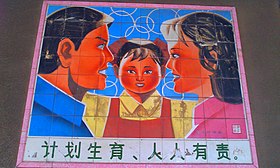
Back Eenkindbeleid Afrikaans سياسة الطفل الواحد Arabic Política de fíu únicu AST Tək uşaq siyasəti Azerbaijani এক সন্তান নীতি Bengali/Bangla Política de fill únic Catalan Politika jednoho dítěte Czech Polisi un plentyn Welsh Etbarnspolitikken Danish Ein-Kind-Politik German


The one-child policy (Simplified Chinese: 一孩政策) was a population planning initiative in China implemented between 1979 and 2015 to curb the country's population growth by restricting many families to a single child. The program had wide-ranging social, cultural, economic, and demographic effects, although the contribution of one-child restrictions to the broader program has been the subject of controversy.[1] Its efficacy in reducing birth rates and defensibility from a human rights perspective have been subjects of controversy.[2]
China's family planning policies began to be shaped by fears of overpopulation in the 1970s, and officials raised the age of marriage and called for fewer and more broadly spaced births.[3] A near-universal one-child limit was imposed in 1980 and written into the country's constitution in 1982.[4][5] Numerous exceptions were established over time, and by 1984, only about 35.4% of the population was subject to the original restriction of the policy.[6]: 167 In the mid-1980s, rural parents were allowed to have a second child if the first was a daughter. It also allowed exceptions for some other groups, including ethnic minorities under 10 million people.[7] In 2015, the government raised the limit to two children, and in May 2021 to three.[8] In July 2021, it removed all limits,[9] shortly after implementing financial incentives to encourage individuals to have additional children.[10]
Implementation of the policy was handled at the national level primarily by the National Population and Family Planning Commission and at the provincial and local level by specialized commissions.[11] Officials used pervasive propaganda campaigns to promote the program and encourage compliance. The strictness with which it was enforced varied by period, region, and social status. In some cases, women were forced to use contraception, receive abortions, and undergo sterilization.[12][13] Families who violated the policy faced large fines and other penalties.[14]
The population control program had wide-ranging social effects, particularly for Chinese women. Patriarchal attitudes and a cultural preference for sons led to the abandonment of unwanted infant girls, some of whom died and others of whom were adopted abroad.[12][15] Over time, this skewed the country's sex ratio toward men and created a generation of "missing women".[15] However, the policy also resulted in greater workforce participation by women who would otherwise have been occupied with childrearing, and some girls received greater familial investment in their education.[16][17]
The Chinese Communist Party credits the program with contributing to the country's economic ascendancy and says that it prevented 400 million births, although some scholars dispute that estimate.[18] Some have also questioned whether the drop in birth rate was caused more by other factors unrelated to the policy.[18] In the West, the policy has been widely criticized for perceived human rights violations and other negative effects.[2]
- ^ Hvistendahl, Mara (18 October 2017). "Analysis of China's one-child policy sparks uproar". ScienceInsider. 358 (6361): 283–284. Bibcode:2017Sci...358..283H. doi:10.1126/science.358.6361.283. PMID 29051354. Retrieved 13 April 2022.
- ^ a b Cite error: The named reference
policy outgrownwas invoked but never defined (see the help page). - ^ Hershatter, Gail (2019). Women and China's Revolutions. Rowman et Littlefield. p. 253. ISBN 9781442215689.
- ^ Kane, P.; Choi, C. Y (9 October 1999). "China's one child family policy". BMJ. 319 (7215): 992–994. doi:10.1136/bmj.319.7215.992. ISSN 0959-8138. PMC 1116810. PMID 10514169.
- ^ "中华人民共和国宪法". gov.cn (in Chinese). Retrieved 22 April 2022.
- ^ Rodriguez, Sarah Mellors (2023). Reproductive Realities in Modern China: Birth Control and Abortion, 1911-2021. Cambridge, United Kingdom: Cambridge University Press. ISBN 978-1-009-02733-5. OCLC 1366057905.
- ^ Kızlak, Kamuran (21 June 2021). "Çin'de üç çocuk: Siz yapın, biz bakalım" [Three children in China: You do it, we'll see]. BirGün (in Turkish). Archived from the original on 16 August 2022.
- ^ McDonnel, Stephen (31 May 2021). "China allows three children in major policy shift". BBC.
- ^ Cheng, Evelyn (21 July 2021). "China scraps fines, will let families have as many children as they'd like". CNBC. Retrieved 29 April 2022.
- ^ Meihan, Luo (13 January 2023). "Shenzhen Offers $2,800 Subsidy for Couples Having Third Child". Sixth Tone. Retrieved 24 April 2023.
- ^ Andrew Mullen (1 June 2021). "What was China's one-child policy and why was it so controversial?". South China Morning Post. Retrieved 13 April 2022.
- ^ a b Kang, Inkoo (9 August 2019). "One Child Nation Is a Haunting Documentary About a Country's Attempts to Justify the Unjustifiable". Slate. Archived from the original on 15 November 2021. Retrieved 15 November 2021.
- ^ Cite error: The named reference
:16was invoked but never defined (see the help page). - ^ Cite error: The named reference
deweywas invoked but never defined (see the help page). - ^ a b Cite error: The named reference
:17was invoked but never defined (see the help page). - ^ Cite error: The named reference
:18was invoked but never defined (see the help page). - ^ Cite error: The named reference
:19was invoked but never defined (see the help page). - ^ a b Cite error: The named reference
bostonwas invoked but never defined (see the help page).
© MMXXIII Rich X Search. We shall prevail. All rights reserved. Rich X Search